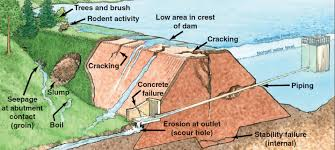Dam types and their specific failure mechanisms significantly influence the nature and severity of disaster outcomes, particularly regarding the speed, depth, and destructive power of the resulting flood wave, as well as the potential for loss of life and property.
Dam Types and Their Susceptibilities
Historically, earthen embankment dams are the most common type of dam to experience failures, largely due to flood events. Approximately two-thirds of existing dams are earthfill dams. These dams are often chosen for their relatively low construction costs and ability to be placed on non-rock foundations. However, they are particularly prone to damages from overtopping or piping (internal erosion) through the dam body or the ground beneath. In fact, nearly 80% of dam accidents involve earth embankments, with overtopping accounting for 50% and piping for 34% of embankment dam failures.
Other dam types, such as concrete arch, concrete gravity, buttress, steel, timber, and composite dams, are also susceptible to failure. While less common in overall failure statistics compared to earthen dams, they can fail due to various mechanisms including overtopping, foundation defects, structural issues like cracking, sliding, or overturning, and equipment failure.
Primary Failure Mechanisms and Their Influence
Dam failures are complex events, often resulting from a combination of factors exacerbated by extreme conditions. The primary mechanisms include:
- Overtopping: This is the most frequent cause, occurring when water flows over the dam's crest, leading to erosion and eventual collapse. Earthen embankments are not designed to be overtopped and are highly susceptible to erosion. Once erosion begins during overtopping, it is almost impossible to stop.
- Piping/Seepage (Internal Erosion): Water seeps through the dam or its foundation, gradually carrying away soil particles and forming channels (pipes), which weakens the structure and can lead to a breach. If fully developed, piping is virtually impossible to control.
- Foundation Defects: Poor foundation conditions, such as settlement or slope instability, can compromise the dam's stability and lead to failure.
- Structural Failures: These involve the breakdown of the dam's physical integrity, such as cracking, sliding, or overturning, often due to poor construction, inadequate maintenance, or seismic activity.
- Inadequate Spillway Capacity: Many dams fail because their spillways cannot handle extreme flood flows, leading directly to overtopping.
- Operational Failures: Human errors or system malfunctions in dam management, such as inadequate gate operations or insufficient monitoring, can contribute to failure.
- Extreme Weather Beyond Design: Unprecedented rainfall magnitudes can exceed a dam's design capacity.
Influence on Disaster Outcomes: The Machchhu Dam Failure Example
The Machchhu II dam failure in 1979 is a stark example of how dam type and failure mechanisms influence disaster outcomes.
- Dam Type: Machchhu II was a composite structure with earthen embankments. Earthen dams are especially vulnerable to overtopping and erosion.
- Failure Mechanism: The primary cause was excessive rainfall and massive flooding leading to overtopping and disintegration of the earthen walls. The actual observed flow was 16,307 m³/s, nearly three times the dam's design capacity of 5,663 m³/s, resulting in its collapse. Efforts to open all spillway gates failed for three of them, further reducing effectiveness. The official claim that the failure was an "Act of God" was debunked, with evidence pointing to structural and communication failures.
- Disaster Outcome:
- Rapid and Destructive Flood Wave: Within 20 minutes, a wall of water 12 to 30 feet (3.7 to 9.1 m) high inundated the low-lying areas of Morbi industrial town located 5 km below the dam. Water levels in Morbi rose to 30 feet (9.1m) within 15 minutes in some areas, remaining under 20 feet (6.1m) of water for the next 6 hours. The initial outflow is typically very high, causing rapid and deep flooding.
- High Casualties and Economic Loss: Estimates of fatalities vary greatly, ranging from 1,800 to 25,000 people, and hundreds of thousands of livestock were killed. The flood caused great economic loss, damaging farmland and decreasing crop productivity.
- Impact of Communication Failures: Despite an early warning broadcast, communication from the dam site failed, and no official warning of the dam failure was issued. Many people in Morbi did not heed the early warning due to familiarity with monsoon season floods, leading to tragic outcomes, such as over a hundred people perishing in a temple they thought was a safe ground.
In conclusion, the type of dam (e.g., earthen versus concrete) dictates its inherent vulnerabilities to specific failure mechanisms (e.g., overtopping, piping). These vulnerabilities, when combined with factors like inadequate design, extreme weather, and operational or communication failures, determine the scale and characteristics of the dam break flood, profoundly influencing the resulting loss of life, property destruction, and long-term societal impacts.


Post a Comment